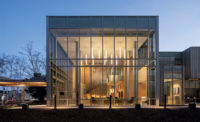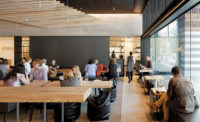A few years ago, as Google started preparing to build two enormous, over-the-top campuses in Silicon Valley—totaling 1.6 million square feet and costing an unspecified sum—the corporation decided to dip its toes in the water with a much smaller, restrained project nearby. The first ground-up building for the search engine company, Google at 1212 Bordeaux in Sunnyvale, California, is not a prototype for either of the forthcoming complexes—a tent-like extravaganza by the Bjarke Ingels Group (BIG) and Heatherwick Studio, and a terraced facility BIG is designing independently. Instead, the 100,000-square-foot office by Charlottesville, Virginia–based Parabola Architecture is testing various strategies for optimizing fundamentals like daylighting, air quality, and acoustics to help employees focus and be productive in an open-plan space. For the most part, the moves are familiar and time-tested options rather than innovative technologies; it is the overall commitment to improving occupant comfort that sets the building apart. “This is essentially a giant mockup that people can interact with, allowing us to collect data on what is and isn’t working,” says Josh Portner, district development executive at Google.
Additional Content:
Jump to credits & specifications
The 200,000-square-foot lot had been occupied by a 1960s-era satellite-manufacturing plant. Because the existing concrete tilt-up structure would have been difficult to adapt, new construction seemed the obvious choice. Google paired the three-person firm of Parabola Architecture (whose principals had previously worked on Google’s master plan and design guidelines) with local Devcon Construction to create a design-build team, for a more efficient and cost-effective process.
Familiar with Google’s leanings, the architects started out with the idea of an exposed unfinished-steel structure and developed the design from there. “We embraced the idea of simplicity and tried to have a building that was responsive and tunable to light, air, and noise,” says Kevin Burke, a Parabola principal. Adds Carrie Meinberg Burke, another principal, “We’re technically driven in our practice. We want to learn more and more about the immutable factors that impact the experience of buildings, so we put our attention toward performance and user comfort.”
From outside, the rectilinear three-story building, with its curtain wall and precast-concrete panels and cornice, blends in easily with its office park neighbors, belying the drama of the space inside. Past a modest lobby, the building opens into a narrow, triple-height space, one of three ground-floor corridors that rise to a luminous sawtooth roof, supported by exposed steel trusses. The building’s lower level is devoted to a café, a bank of meeting rooms organized compactly between the corridors, and desk space to the north. The main open work area occupies the second floor: a double-height, largely column-free piano nobile that is ringed above by a mezzanine level with additional desks. Glass-walled meeting rooms line the floor’s perimeter, allowing daylight to penetrate its center. While providing an optimal work environment, this soaring space was also a response to zoning requirements: the floor-area ratio restricted the total square footage of the building, but permitted greater height.
Pushing the service core to the building’s south end (rather than locating it in the center) also helped the team create the second floor’s large, continuous expanse, which enables flexibility for subsequent uses. Given the rapidly evolving nature of office work, Google wanted to avoid building too many enclosed spaces and is considering the use of “pop-up” conference rooms. While the building currently holds approximately 500 people, the company plans to increase the density of desks to test out the ideal ratio of workstations to collaborative areas; staff can choose to work at their own assigned desks or in various common areas. Addressing the elevated noise levels that often come with the open plan, the team used the service core as an acoustic buffer between the noisy café areas and desk spaces. Noise is further mitigated by metal acoustical decking throughout, screens and railings of white oak slats that do double duty as acoustic panels, and a soundmasking system that is specifically tuned to voices to prevent conversations from traveling.
While flooding the building with light, the sawtooth roof’s glazing offers glimpses of the sky, another attribute valued by Google. “We believe that giving people access to nature in some way—to be able to see out and understand what time of day it is and what season it is—is really important,” says Mary Davidge, director of campus design at Google. “Every person in this space can do that, which is difficult with a 40,000-square-foot floor plate.” To reduce glare, the design team oriented the roof’s glazing to the north and included terraces whose metal overhangs shade the southern exposure. The building also has automated exterior blinds on all sides. Addressing another quality-of-life issue—air flow—the team employed a system used in laboratories: a centralized sensor continually monitors the interior environment and adjusts ventilation accordingly.
Since Google staff only moved in this past January, it is a bit early for the company to say that the trial run has been a definitive success. It is collecting quantitative data using a series of sensors that allow it to compare reality to computer models, as well as gathering employee feedback through online surveys. But, based on initial responses, it’s very likely that most of the building’s design elements will be implemented in the bigger projects. “Unlike some of our other buildings, where we’ve gotten hundreds of complaints right away,” says Portner, “for this one, people have submitted positive feedback, which is highly unusual.”
Back to Good Design Is Good Business 2018
CreditsArchitect / Project Lead Designer Parabola 614 Park Street, Charlottesville, VA 22902 434-960-4135 www.parabola-architecture.com
Personnel in architect's firm who should receive special credit: Carrie Meinberg Burke AIA – Design Partner, Kevin Burke AIA – Design Partner, Ryan Carbone – Designer, Matthew Wagner NCIDQ – Consultant, Mark Graham AIA – Consultant
Architect of record: Devcon Architecture: Pamela Warren AIA, Sean Gillin – Assoc AIA, Jolyn Winner – Assoc AIA 690 Gibraltar Drive Milpitas, CA 95035 408-942-8200 http://devcon-const.com
Interior designer: Interior Architecture: Parabola Interior Design & Furnishings: Rapt Studio
Engineers: Structural: Nishkian Menninger Civil: Kier & Wright Mechanical / Electrical / Plumbing / Integrated Design: Point Energy Innovations Daylighting / Integrated Design: Integral Group Acoustical: Charles M. Salter Assoc. Inc. Lighting: Point Energy Innovations / Clanton Associates
Design Consultants: Ecological / Habitat: H.T. Harvey & Associates Landscape: O’Shea Wilson Siteworks / Parabola Code / Fire: The Fire Consultants Waterproofing: Simpson, Gumpertz & Heger LEED: Point Energy Innovations / Kath Williams & Assoc
Design-Build and Design-Assist Subcontractors: Structural Steel: Gayle Manufacturing Buckling Restrained Bracing: CoreBrace Precast Concrete: Willis Construction Inc Glass & Glazing: Walters & Wolf Stairs / Rails / Misc Metals: Glazier Steel Electrical / Lighting: Redwood Electric Group HVAC / Plumbing: ACCO Engineered Systems Grading / Paving / Site Concrete: Joseph J. Albanese, Inc Architectural Woodwork: Complete Millwork Services Exterior Blinds: Peninsulators / Draper Inc Food Service Equipment: Trimark Raygal Inc Sound Masking: Archoustics West Commissioning: Enovity Inc.
Design-Build Contractor: Devon Construction John Castagnoli – Project Executive, Laura Zanger – Project Manager, Daniel Thelin – Project Superintendent, Paul Salinero – Assistant Superintendent
Photographer: © Google / Prakash Patel Photography |
SpecificationsStructural System Manufacturer of any structural components unique to this project: Steel framing: Gayle Manufacturing Company Acoustic metal deck: ASC Steel Deck
Exterior Cladding Unitized glass & aluminum curtain wall: Walters and Wolf Board-formed prefabricated concrete panels: Willis Construction Inc. Wood cladding: Accoya Corten steel canopy & garden gates: Glazier Steel Custom downspouts: Air Systems / EMCOR Exterior automated blinds: Draper Exterior fixed louvers: Draper
Roofing TPO roofing: Carlisle Metal: Morin Architectural Metal
Windows Anodized aluminum interior storefront: Walters and Wolf
Glazing Exterior: Viracon Interior Fire Rated: Technical Glass Products
Doors Entrances: Walters and Wolf Metal doors: Door Components, Inc. Wood doors: Architectural Wood Doors Fire-control doors: United California
Hardware Locksets: Schlage Oil rubbed bronze levers: Schlage Closers: LCN Exit devices: Von Duprin Pulls: Walters and Wolf custom Security devices: Owner’s proprietary
Interior Finishes Acoustical ceilings: Armstrong Optima Suspension grid: Armstrong Industries FSC Cabinetwork and custom woodwork: Complete Millwork Services Paints and stains: Mineral Paint (C2C): Romabio Stain: Rubio Monocoat Raw steel finish: Tried & True Danish Oil Wall coverings: Calico custom, 180 WEST custom Paneling: Accoya Solid surfacing: Neolith Floor tile: DalTile Wall tile: Fireclay Tile (local handmade) Carpet: Bentley Trance (C2C certified backing) Raised flooring: TecCrete Special interior finishes unique to this project: Bark wall at Lobby (C2C Platinum): Barkhouse Custom acoustic & functional FSC white oak bookledge: Complete Millwork Services Acoustic wood slat & cotton panels: Acoustigreen / Complete Millwork Services Acoustic wall panels: Polymax with Sonocoat Oiled raw steel stairs & railings: Glazier Steel Custom palladium leaf LEED Platinum plaque gilded on steel column and recycled gold leaf address numbers by Gentleman Scholar Signs
Furnishings Office furniture: Pear – One Workplace Reception furniture: Ohio Designs, Makr, Uhuru, Davis, Usona/Cypress, Andriannna Shamaris, DWR/Taccini, 100xbtr Fixed seating: Sedia, Northwood Chairs: Steelcase, Bludot, Muuto, Allermuir, Nuans, Stylex Tables: Pair, HPL, Northwood, HCSI/HPL, SIS
Other furniture: Ancillary: Arper, Northwood, Blu Dot, Artittud/Artifort, Concrete Pig, Arper, Buzzi, Carl Hansen, Roger and Chris, Muuto, Danish Design Store, Pfeifer Studio, Naughtone, West Elm, Industry West, Makr, Sossego, The Future Perfect, Hem, Tom Dixon, Atelier, DeVorm, Zachary A, Magis, Bernhardt, Citizenry Garden: Room & Board, Janus Et Cie, Kettal, HCSI/ITSconcrete, Emeco, Property Furniture, DWR, Landscape Forms
Lighting Interior ambient lighting: Optic Arts, Bruck, Finelite, Philips Color Kinetics Downlights: Gotham, Halo, Eureka, Amerlux Tasklighting: Finelite, Metalux Exterior: BEGA, we-ef, Hevi Lite, Gotham, Modern Forms, Birchwood Lighting, Eaton Dimming system or other lighting controls: Enlighted, DMX (Philips iPlayer3)
Conveyance Elevators/escalators: Kone
Plumbing Sinks: Elkay Lavatories: Kohler Water closets: TOTO Showers: Bricor
Energy Energy management or building automation system: Photovoltaic system: SunSystem Technology Other unique products that contribute to sustainability:
Add any additional building components or special equipment that made a significant contribution to this project: CO2 Sensors: Aircuity Sound masking: Archoustics West / Logison |












.jpg?height=200&t=1721332020&width=200)
